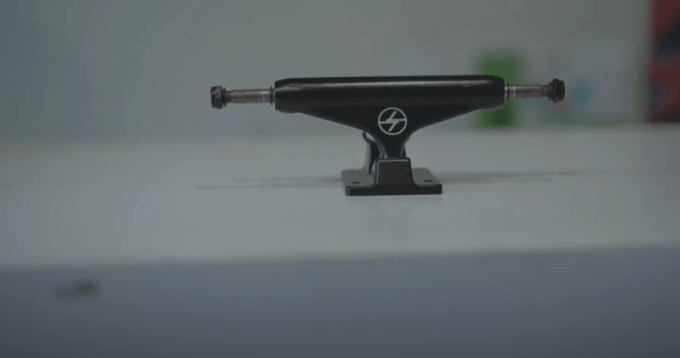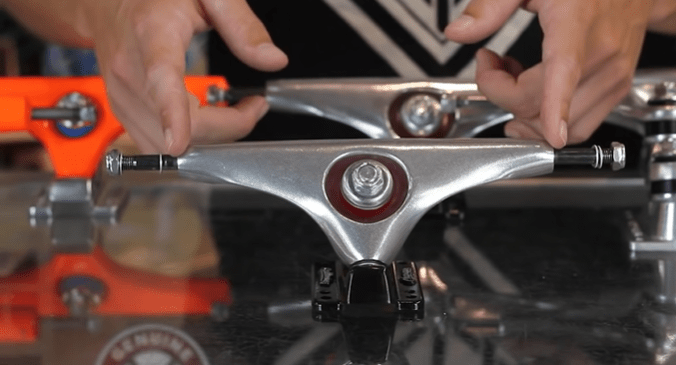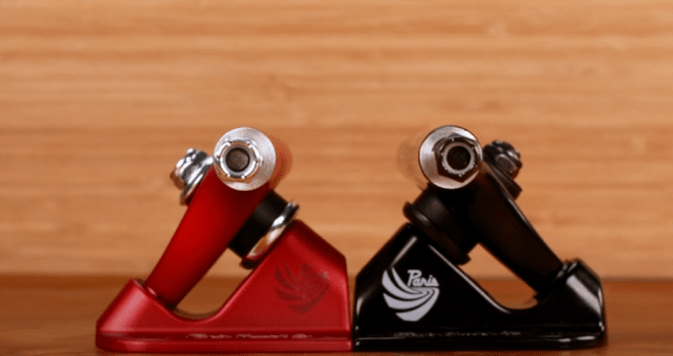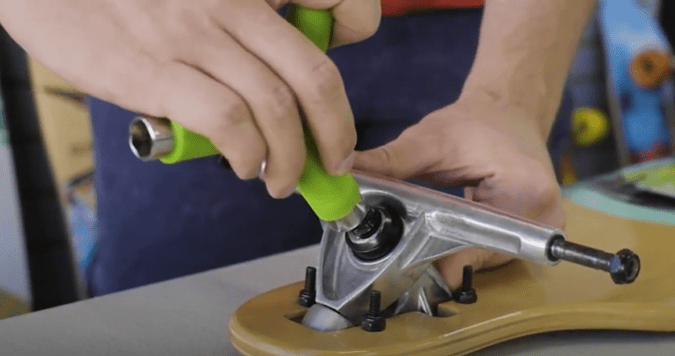

Skateboards, including longboards, are made up of several components, one of which are trucks. Trucks are metal pieces that are attached to the bottom of the board and serve as the base for the wheels. Every longboard needs two trucks in order to move.
The characteristics of trucks can vary based on size, kingpin placement, base angle, and manufacturing process. The most commonly used trucks in longboards have the kingpin positioned in a reverse manner, making them known as “reverse kingpin trucks” or RKP. These trucks offer greater stability and maneuverability compared to traditional kingpin trucks, also known as TKP, which are better suited for handling rough terrain and heavy use.
Trucks consist of various parts such as the hanger (also known as the “T”), pivot tubes (pivot cups), bushings, axles, bases, washers, nuts, and kingpin. These parts can often be purchased separately, either to replace worn-out components or to customize the way the truck performs and feels.


The truck of a skateboard, including a longboard, is made up of various components, each of which serves a specific purpose for its proper functioning. Here, we will briefly explain some of these components.
The axle is the metal pin that the wheels are mounted on. In most cases, the axle runs from one side of the truck to the other, but there are also truck models where the axle is screwed to the ends of the hanger. The axle can either be mounted on the hanger when making cast trucks or inserted after the hanger is made. In precision trucks, the axle can also be screwed in place.
A bent or misaligned axle can affect the grip and wear of the wheels, so in critical applications, they may not perform as well. The quality of the axle varies based on its composition and the manufacturing process of the truck. Cast trucks generally have weaker axles that are more likely to be installed at a bad angle from the factory. Pressed-in axles in the hanger are not affected by the high temperatures of the molten aluminum and offer better control over the final position in the hanger. Bolted trucks are typically made of high-quality materials and precision-machined, making them the highest quality option.
The “T” or hanger is the metal piece in the shape of a triangle that makes up the majority of the truck. The axle is installed in this piece.
There are three main techniques for manufacturing the hanger: aluminum casting (cast), forging, or precision cutting. Properties vary depending on the manufacturing method. Cast trucks are the most economical, but also have less control over measurements and quality due to variations in the mold and changes in the cooling process. Forged hangers are stronger and have lower tolerances because the manufacturing process does not melt the aluminum, but instead, presses it, resulting in stronger joints than cast or precision trucks. Precision trucks are cut from a block of aluminum using computer-controlled precision machinery.
The area where the bushing sits in the hanger should be given special attention. Some hangers have restrictive walls that make the truck stiffer, while others are more open. In some cases, they may have tiers that provide varying levels of resistance to load time folding.
The position of the axle in relation to the “T” also affects the feel of the truck, also known as rake. A truck with the axle fully centered will have linear turning characteristics that respond directly to the rider’s weight or input. A truck with a rake will initially not respond to the rider’s input, but as weight is added, the turning ratio increases.


The kingpin is the central screw in the truck that holds all its components together, including the base, washers, bushings, and the hanger. Kingpins come in different grades of steel, with grade 6 being the most commonly used for its strength and durability. In recent years, kingpins made from alternate materials, including hollow center options, have been used to reduce the weight of the skateboard without sacrificing durability.
The bushings are soft urethane rings that are located around the kingpin and play a crucial role in allowing the truck to turn smoothly and with stability. To get the best performance from your truck, it is important to choose the right bushings based on your skating style and weight. Over-tightening the truck nut to increase stiffness can negatively impact the agility of the truck and cause the bushings to lose their effectiveness. Different bushings come in different hardness, shapes, and formulas, so it is important to test them in combination with your truck to find the best fit.
The base is the rectangular metal piece that attaches the skateboard to the rest of the truck. Like the hanger, the base can be manufactured through casting, forging, or precision cutting. The angle of the truck refers to the angle between the hanger and the base, and it has a direct impact on the truck’s response to turning and the amount of lean by the rider. A common misconception is that a truck with a smaller angle is more stable, but in reality, this can make the truck harder to turn and increase the amount of lean required by the rider. The best truck for you will depend on how you feel when riding, and a truck with a 50-degree angle is often a good starting point as it provides a good balance of response and stability at both low and high speeds.


The wheelbase and truck width are important factors to consider when it comes to the performance and feel of your skateboard. Understanding these elements will help you find the best setup for your needs.
The wheelbase is the distance between the two wheels of the truck and is determined by factors such as the height of the truck, deck type, wheel size, and truck angle. Finding the right balance between these components is crucial to ensure a smooth ride. It’s important to remember that the wheelbase should be tested while riding, as simply standing on the deck will not provide an accurate assessment.
Lower-angled trucks tend to cause more wheelbite, meaning the wheels come into contact with the deck during turns. To avoid this, you may consider using larger wheels or a higher-angled truck. If you prefer to keep larger wheels for increased speed, adding risers or pads can help increase the clearance between the wheels and deck.
The width of the truck used to be chosen based on the width of the deck, but now there is a trend towards selecting a truck width that fits the rider’s performance needs. Narrower trucks are more responsive to the rider’s movements and provide better traction due to the smaller gap between the wheels. On the other hand, wider trucks are less responsive but offer more stability.
Ultimately, the right truck width will depend on the rider’s preferences and style of riding. Experimenting with different setups can help you find the best fit for you.


If you are feeling uncertain about which skateboard truck is the best fit for you, don’t worry, it is common for riders to go through a trial and error process to find the right one. This guide will provide you with a deeper understanding of how the truck affects the performance of your skateboard and how different parts interact with each other. This way, you will be able to make a more informed decision and save time by testing fewer trucks before finding the perfect one.
